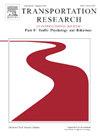中国青年驾驶员危险驾驶量表同伴压力的心理测量特征及其与危险驾驶行为和朋友间安全驾驶氛围的关系
IF 3.5
2区 工程技术
Q1 PSYCHOLOGY, APPLIED
Transportation Research Part F-Traffic Psychology and Behaviour
Pub Date : 2025-02-15
DOI:10.1016/j.trf.2025.02.011
引用次数: 0
摘要
目的将风险驾驶同伴压力量表(Peer Pressure on risk Driving Scale, PPRDS)应用于中国青年驾驶员,并考察其与朋友间风险驾驶行为和安全驾驶氛围的关系。方法660名年龄在18 ~ 25岁的司机同意参加本研究。测量包括PPRDS,朋友间安全驾驶气候量表(SDCaF)和危险驾驶行为量表(RDBS)。结果探索性因子分析(n = 323)和验证性因子分析(n = 324)的结果形成一个包含20个条目的三因子量表。这三个因素分别是鼓励风险的直接、阻碍风险的直接和间接的同伴压力。PPRDS因子的信度范围为0.85 ~ 0.95。PPRDS、SDCaF和RDBS因子之间的显著相关性表明,PPRDS具有可接受的并发效度。3个因子的平均方差提取(AVE)值在0.526 ~ 0.673之间,具有较好的收敛效度。最重要的是,发生交通事故的司机在风险鼓励的直接和间接同伴压力方面的得分明显高于没有发生交通事故的司机,这表明PPRDS具有令人满意的已知组效度。结论修订后的PPRDS具有良好的信度和效度,可用于青年驾驶员的评价、分类和考核。本文章由计算机程序翻译,如有差异,请以英文原文为准。
Psychometric properties of the peer pressure on risky driving scale in young Chinese drivers and its associations with risky driving behaviours and safe driving climate among friends
Purpose
The present study aimed to translate and adapt the Peer Pressure on Risky Driving Scale (PPRDS) to young Chinese drivers and examine its relationships with risky driving behaviours and safe driving climate among friends.
Methods
Six hundred sixty drivers aged 18 ∼ 25 years agreed to participate in this study. The measurements included the PPRDS, Safe Driving Climate among Friends Scale (SDCaF) and Risky Driving Behaviour Scale (RDBS).
Results
The results of exploratory factor analysis (n = 323) and confirmatory factor analysis (n = 324) yielded a three-factor scale with 20 items. The three factors are risk-encouraging direct, risk-discouraging direct and indirect peer pressure. The reliability of the PPRDS factors ranged from 0.85 to 0.95. The significant associations among the PPRDS, the SDCaF and the RDBS factors suggested that the PPRDS had acceptable concurrent validity. It also had acceptable convergent validity, with the average variance extracted (AVE) values of the three factors ranging from 0.526 to 0.673. Most importantly, drivers with traffic crash scored significantly higher in terms of risk-encouraging direct and indirect peer pressure than did drivers without traffic crash, indicating that the PPRDS had satisfactory known-group validity.
Conclusion
These findings indicate that the revised PPRDS has satisfactory reliability and validity, making it useful for young driver assessment, classification and testing.
求助全文
通过发布文献求助,成功后即可免费获取论文全文。
去求助
来源期刊
CiteScore
7.60
自引率
14.60%
发文量
239
审稿时长
71 days
期刊介绍:
Transportation Research Part F: Traffic Psychology and Behaviour focuses on the behavioural and psychological aspects of traffic and transport. The aim of the journal is to enhance theory development, improve the quality of empirical studies and to stimulate the application of research findings in practice. TRF provides a focus and a means of communication for the considerable amount of research activities that are now being carried out in this field. The journal provides a forum for transportation researchers, psychologists, ergonomists, engineers and policy-makers with an interest in traffic and transport psychology.

 求助内容:
求助内容: 应助结果提醒方式:
应助结果提醒方式:


